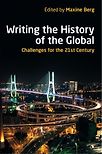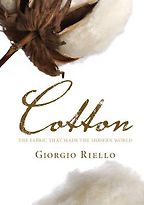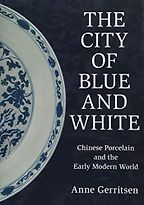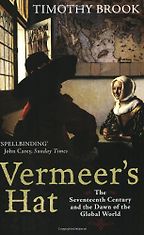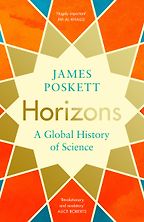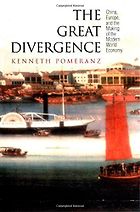Before we get on to the books I want to ask you about global history’s emergence as a discipline. It’s quite a big thing now. When and why did that happen? Was it a result of historians seeing the limitations of a narrower focus in historical writing? Or was it about changes in the outside world, globalization happening and historians becoming more conscious of that?
Many, many people take that latter position, that historians were just responding to globalization. I don’t think that is the reason why historians took up this field when they did, and in the way that they did. I think we have to look at a much wider intellectual history. Historians are intellectuals and we have to look at their work much as they would look at the texts of earlier political or social thinkers, and set them in their intellectual context, and not just see what they do as knee-jerk reactions to changes happening in the economy and the wider world. So I do not accept this version, that we just joined in with globalization.
I remember going to sessions run by the politics department or the sociology department in the 1990s looking at the impact of globalization on British industry, these very contemporary topics. I was originally trained as an economic historian. I was in an economics department for 15 years so I have these wider social science interests. But I never saw another historian at any of these meetings. There were a few economic historians, but they were really economist-economic historians, and that was the direction they were coming from, asking questions like ‘was there a convergence of prices as trade increased?’ I really don’t think that globalization had caught on then.
The big shift came in the later 1990s. There was an interest coming from a group in California looking at Chinese history. They were historians of China debating with historians of Europe, that’s where things really started to gel.
And that’s the background to your first book choice, Ken Pomeranz’s The Great Divergence, published in 2000, isn’t it?
Yes. Pomeranz was in a group of historians and historical sociologists in the California system, including UC Davis and Irvine and UCLA historians. They were debating these issues of comparative history and what became known as global history. There had been world histories before this and some, like Ken Pomeranz, were very much engaged in the world history movement. There had long been a Journal of World History; indeed there was a whole subject area called ‘world history.’ This was replacing ‘western civ’ courses in American universities, in the school system and also, interestingly, in the American military academies. One of the early global historians, Jerry Bentley, who was also very much engaged in world history, told me he thought the origins were in the American military academy, where they were trying to give all these soldiers that they were sending around the world some background in other people’s histories, because they really only received American history at school and university.
“Global history is a way of thinking”
So there was that older tradition, but it was mainly a teaching tradition. It was not a tradition of research initiatives in new directions in historical research. That really all started with those debates that were going on in this California school and the wide impact of Ken Pomeranz’s The Great Divergence. He was looking at China in comparison with Europe, not Europe in comparison with China, with China always being the lesser player. He tried to develop what he called ‘reciprocal comparison,’ looking at the region that you’re dealing with through the lens of another region. His is a comparison between China and Europe in the period leading up to 1800.
He made this quite big claim that China was equal to Europe right up to 1800. Then the paths diverged. It was a very big claim to make at that time. He compared natural resources, he compared agricultural systems, he compared industries, and went through all these comparisons. He also zeroed in on a comparison between the Yangtze Valley and Britain, because Britain was the first country to witness the Industrial Revolution and the Yangtze Valley was the most highly developed area of China that transformed from the 16th century into the 18th century.
I cannot tell you how exciting that book was when it hit the press. It was a Princeton University Press book, so very much an academic publisher, but one looking out for new directions, in fields being developed. Pomeranz was almost instantly on a lecture tour all over the world and for at least two years after that book was published; it was being read everywhere.
Let’s move on to Giorgio Riello, Cotton: The Fabric that Made the Modern World. Tell us about this book.
The cotton industry was one of the key drivers and the most traditional explanation used for the industrial transformation of Europe. Then, later, it was taken up in explaining industrial revolutions in other parts of the world.
So many of the approaches that we had to the cotton industry had been Europe-centered, particularly British-centered, and even Lancashire-centered. This book set the whole framework of the development of the cotton industry in its wide global context. It showed that the really important framework was not just technologies and the development of access to cotton resources, but the markets for Indian cottons. It was Indian cottons—their quality, the way that they had been dyed with fixed dyes and the way that they could be printed in vibrant and colourful patterns—that were a huge attraction to Europeans, to people in Southeast Asia and the Americas and markets in many parts of the world. There was this big trade in these cotton goods from India from very early on, the 14th and 15th centuries, and a smaller trade centuries before this. These cottons from Gujarat travelled up through the Middle East and East Africa—there were big markets in East Africa as well.
Get the weekly Five Books newsletter
Indian merchants, with their versatile sailing ships, the dhows, sailed right round India down into Southeast Asia, trading their cottons into Southeast Asia for spices, the cottons then being traded with Chinese merchants. So this was a big Asian and African product before it was a European industrial commodity. It was also a high-quality product. Printing and the fine quality of the cottons were very, very important to its story. Very few, before Riello wrote this book, claimed anything other than that Britain could produce this cotton cheaper because it developed machines to do so. The traditional view posed that the low cost of cotton goods drove consumers to replace their linens, silks and woollens. But this book offers very much a consumer-led explanation, an explanation based on cotton’s quality, fashion and design. It transformed the whole way that we have looked at why the cotton industry took off as and when it did.
Does he go on to talk about the Industrial Revolution and Britain’s role?
Yes, there was a huge demand for cotton goods. There were blockages in the market from India, especially after the middle of the 18th century. There were access problems as demand rose rapidly. What happened in Britain, first of all, was that textile manufacturers produced a combination of linen and cotton, called fustian. It was a cheaper fabric. It was dyed and printed, but the quality difference was huge. So there was a big drive on to improve the technologies in order to use more cotton and less linen. This required access to high-quality cotton, because those early machines—the jenny, the water frame, the mule—all worked best with high-quality cottons. In their early phases, those high-quality cottons were brought from Brazil and the Caribbean using slave labour. Slavery is fundamental to that early transition of the British and European cotton industries.
Riello demonstrates this and how British markets developed in competition with producers in India. There was a drive to imitate those Indian textiles and to produce these in European colourways and designs. The British didn’t produce something better, but they did produce a version that was attractive to wide markets. They had real problems with the African market. The African markets were highly specialized and demanded high luxury cotton textiles; they sought out Indian textiles. It took a long time for the British to break into those markets, but they needed these markets because they traded textiles for enslaved people.
Let’s move on to The City of Blue and White: Chinese Porcelain and the Early Modern World by Anne Gerritsen.
This is a wonderful book. Anne Gerritsen is a historian of China, of the Song and early Ming dynasties. She was a literary historian, but she worked on the region in China where the great city of Jingdezhen was located, in the Jiangxi region. Anna Gerritsen teaches at Warwick University, and she regarded herself as a local historian. But the local historians in the history department there at that time were mostly European historians, and they had a peculiar preconception that a Chinese historian was a modern historian. So they did not engage with her.
I had started an 18th-century reading group at Warwick, and we were discussing consumption and luxury goods. The luxury good I myself was very interested in at that time was porcelain, its development and how it was imitated in Europe, and more generally the impact of Asian luxury goods on Europe. There was this great city that produced most of the porcelain for China and for the world in her region of study, and she started to research the city as a local historian.
“The fine ceramics of the world were all produced in this one place in China”
So her book is an urban history. It’s a history of how the fine ceramics of the world were all produced in this one place in China, up until Europe and other places learned the porcelain recipe in the early 18th century. Nearly all of that blue and white porcelain that is so famous all over the world was produced from this one city. The city held huge factories, far beyond the extent and the size of any factory in the European industrial revolution.
This is a great, scholarly book, an urban history, a history of porcelain, a history of the migrant workforce that was brought into this city, to work in these huge kilns. These kilns produced whatever anybody wanted. They were very receptive to all the different design techniques. And there were huge markets in the Middle East and South east Asia. The Koran stated that it was not right to eat off gold and silver. Wealthy and even more middle status Islamic consumers ate off porcelain. The significance of this place, Jingdezhen, needed to be told to the world, and this is the book which has done so.
When was it actively producing porcelain? When was its heyday?
There were other porcelain centres and they produced different types of porcelain. The production of porcelain certainly goes back into the Tang Dynasty. It’s an ancient craft, and was produced in different parts of China in during the Song Dynasty, too. But it’s really from the 12th century onwards that we see the development in this region, and it’s particularly important as a world centre during the Ming Dynasty from the 14th century onwards. It’s a big centre still.
There was an exhibition in the Turbine Hall at the Tate Modern not so many years ago by Ai Weiwei, his great sunflower seed exhibition. All of those sunflowers seeds were made of porcelain and hand painted in Jingdezhen, and there were probably millions of them. The people of Jingdezhen, at that point, didn’t seem to know about their significance in the world. But they were very grateful to Ai Weiwei, who had given them good work for some time producing all of these flowerseeds. There’s also a famous shard market in Jingdezhen because builders and many others are digging up all these shards of these ancient porcelains, even now.
Next up is Vermeer’s Hat: The Seventeenth Century and the Dawn of the Global World by Tim Brook.
This was written quite early on in the global history initiative. Tim Brook is also a historian of China. He has written on Chinese cities and has done a lot of work on the Ming Dynasty. He’s not an art historian, but a cultural and social historian of China. This book was a kind of entry for him into global history. He chose the perspective of writing about some of Vermeer‘s paintings, taking a microscopic look at those paintings and the objects depicted in them. He then followed out from those objects to tell a story of the 16th and 17th centuries, especially 17th-century global history. Each chapter starts with a different object. There’s a beaver hat, there’s smoking, porcelain, Turkish carpets. It’s a book written for a wide audience. It wasn’t intended as a scholarly work. But it told the wider reading public about this whole new approach to writing about the world. It’s beautifully written, and starts off with him falling off his bicycle in Delft, and then his entry into discovering this wide world of objects. It’s very much an object-based entry into global history.
Let’s move on to Horizons: The Global Origins of Modern Science by James Poskett.
This is a new book and it tackles one of the subjects that has been most difficult to incorporate into global history, and that’s the history of ideas, intellectual history, and especially the history of science, which is very much part of the history of ideas. James Poskett introduces us to these European-based histories of science. As written from the late 19th century onwards, wherever the history of science has reached out to the wider world, it has always been considered as something that was transmitted from Europe, and picked up and adapted in other parts of the world, not that other parts of the world were making any major contribution to scientific endeavour and scientific progress in themselves.
He discusses very different conceptions of science. Is it something that just takes place in the lab? We often think of it that way. Or is it in the minds of so-called great scientists? It’s also technology. It involves many different practices that, for some time now, historians have been presenting more as a history of knowledge than a history of science. But he sets this knowledge framework within the domain of the history of science. He takes us through these worlds of Copernicus, of Newton, of the atom, and all these traditional subject areas, but he shows how much they were created just as much by connections and endeavours from other parts of the world. Newton could not have done his work without the data that was being collected around the world, for instance from merchants, travellers and, indigenous peoples in various parts of the world collecting information on the tides. He was embedded in this world of data collecting. There’s wonderful material on natural history and the way that practices and collections were introduced to Europeans by indigenous groups in many parts of the world; the use of resources brought into Europe by these encounters, and how we just could not have had the kind of European science that developed without this interaction.
Five Books interviews are expensive to produce. If you're enjoying this interview, please support us by donating a small amount.
Another very interesting point is that the great advances of Islamic science during the medieval period have always been acknowledged, but it’s always presented as a story of decline after that; similarly, with Indian mathematics. He shows us that in both instances this was certainly not the case. He also makes the point that China is growing faster than anywhere else, and that it is a great science centre now. We need to know that this isn’t something that has just happened now—there is a long history to it.
It’s a fascinating book, also written for a broad audience, and based on recent scholarship over the past 10 to 20 years. Certainly over the past 10 years there’s been a movement among historians of science to investigate the contributions of what they call ‘go-betweens’ and the indigenous roots of a number of scientific hypotheses and experiments.
Finally, tell me about your book, Writing the History of the Global: Challenges for the 21st Century. What issues were you and your co-authors trying to address in that?
It was published in 2013, based on a conference that was run in 2009. Many famous historians contributed to the book. It’s very much tied to that conference, which brought together historians from many different fields and many areas of the world. It was not just a group that self-identified as global historians. Among the themes of the book was the question of how the challenge of the global was affecting historical research and writing.
It’s been nearly ten years since the book came out. When people are looking for introductions to the field, this has been one of the go-to books because it sets out that moment of transition for historians as a whole engaging with this field. We interviewed a number of these historians. There is an archive of conversations with all these historians at the time, in addition to those who contributed to the edited volume, so that is another great resource.
I should say that since the book was published, there has been a great deal of critique and rethinking of global history. People have raised really serious questions with which we need to engage. Two of the things we never talked enough about were war and slavery. My new book, which I have co-authored, is on slavery and the Industrial Revolution. We asked ourselves, a global approach to history was great for people who were on the move, but what about those who just stayed at home? What happened with them? How do we write about them as part of the world? There’s also been a more recent discussion of capitalism. What intervention can global history make in our histories of capitalism? What part do we play there? So there has been a lot of critique recently, but I think it has pushed new thinking. There are lots of problems in the world now, but we’re intellectuals and we need to reflect on this. We don’t just have knee-jerk reactions.
I hope we never abandon global approaches to our history writing and go back to those old national histories and area studies. I hope global history will continue.
Get the weekly Five Books newsletter
I also want to make a very strong plea that we continue to write our locally-focused histories. Our local histories are absolutely fundamental. We are historians, we go to archives, we want to find out the nitty-gritty of how events occurred, how social structures emerged, and how ideas were formed. We need to have our feet on the ground where we research. Global history is a way of thinking. It’s a way in which you approach your materials, your archives. It raises the questions that you want to ask of your materials, but we need to preserve our deep, archival understanding of the subjects we research.
Five Books aims to keep its book recommendations and interviews up to date. If you are the interviewee and would like to update your choice of books (or even just what you say about them) please email us at [email protected]

